As an Amazon Associate KitchenwareSets.com earns from qualifying purchases.
7 Smart Kitchen Layout Plans for Any Size and Style
Feeling overwhelmed trying to plan your kitchen? You’re not alone. Staring at an empty room or an outdated space while trying to imagine the perfect flow of cabinets, appliances, and countertops can be paralyzing. The internet is flooded with beautiful pictures, but it’s hard to know which kitchen design ideas will actually work for your home, your family, and your budget.
You might be asking yourself: Where do I even begin? How do I make sure my new kitchen is not just beautiful but also incredibly functional? The fear of making an expensive mistake can stop a dream kitchen renovation in its tracks before it even starts. You need a clear, simple guide that cuts through the noise and shows you the proven blueprints for a great kitchen.
The best kitchen layout is one that optimizes the “work triangle”—the path between the stove, sink, and refrigerator. This simple principle is the foundation of functional kitchen design. Popular layouts like the L-shape, U-shape, and Galley are all designed to make this workflow efficient for different kitchen sizes and shapes, ensuring your dream kitchen is as practical as it is stunning.
Overwhelmed by Kitchen Layouts? Here’s How to Find the Perfect Plan for Your Home
The best kitchen layout is one that optimizes the “work triangle”—the path between the stove, sink, and refrigerator. Popular layouts like the L-shape, U-shape, and Galley are designed to make this workflow efficient for different kitchen sizes and shapes. Choosing the right plan can feel like the biggest hurdle in any home renovation, but it doesn’t have to be. Forget the endless scrolling and confusing technical drawings. This guide is designed to be your simple, visual starting point.
We’ll break down the most popular, time-tested kitchen floor plans that professional designers use every day. By understanding the core strengths of each layout, you can easily identify the one that fits your space, your cooking style, and your life. This guide is built on foundational design principles and an analysis of hundreds of successful kitchen plans, all simplified to make your decision easy and confident.
Understanding the Kitchen “Work Triangle”
The kitchen “work triangle” is a design principle that connects the three main work areas: the refrigerator, sink, and stove. For maximum efficiency, the distance between each of these points should be between 4 and 9 feet, and the total of all three sides should be between 13 and 26 feet. This classic rule is all about creating a compact, efficient path that minimizes the steps you take while preparing a meal.
Here’s how to think about it:
- The Concept: Imagine lines drawn on your floor connecting your fridge, sink, and stove. The goal is to keep this triangle clear of major traffic paths (like a doorway) and obstructions (like a poorly placed island).
- The Goal: A well-designed work triangle saves you time and energy. Everything you need for prepping, cooking, and cleaning is within a few steps.
- The Modern Twist: “Work Zones”: While the triangle is a fantastic starting point, modern kitchens often serve more functions than just cooking. Many designers now think in “work zones.” This is a more flexible approach that groups items by task. For example, you’d have a “prep zone” with knives and cutting boards near the sink, a “cooking zone” with pots and spices near the stove, and a “cleaning zone” with the dishwasher and trash can near the sink. This concept is especially useful for kitchens with multiple cooks.
7 Smart Kitchen Layout Plans for Any Size and Style (2025 Update)
The 7 most common kitchen layouts are: 1. One-Wall Kitchen, 2. Galley Kitchen, 3. L-Shaped Kitchen, 4. U-Shaped Kitchen, 5. G-Shaped Kitchen, 6. Kitchen with an Island, and 7. The Peninsula Kitchen. These seven configurations are the foundational blueprints for almost every functional and beautiful kitchen. Whether you’re working with a tiny studio apartment or a sprawling open-concept space, one of these plans will be the perfect fit.
Below, we’ll dive into each layout with clear explanations, practical advice, and inspirational ideas. These are industry-standard designs proven to optimize workflow and space, curated with tips and lessons learned from years of professional kitchen design experience to help you make the best choice for your home.
1. The One-Wall Kitchen: Ultimate Space-Saver
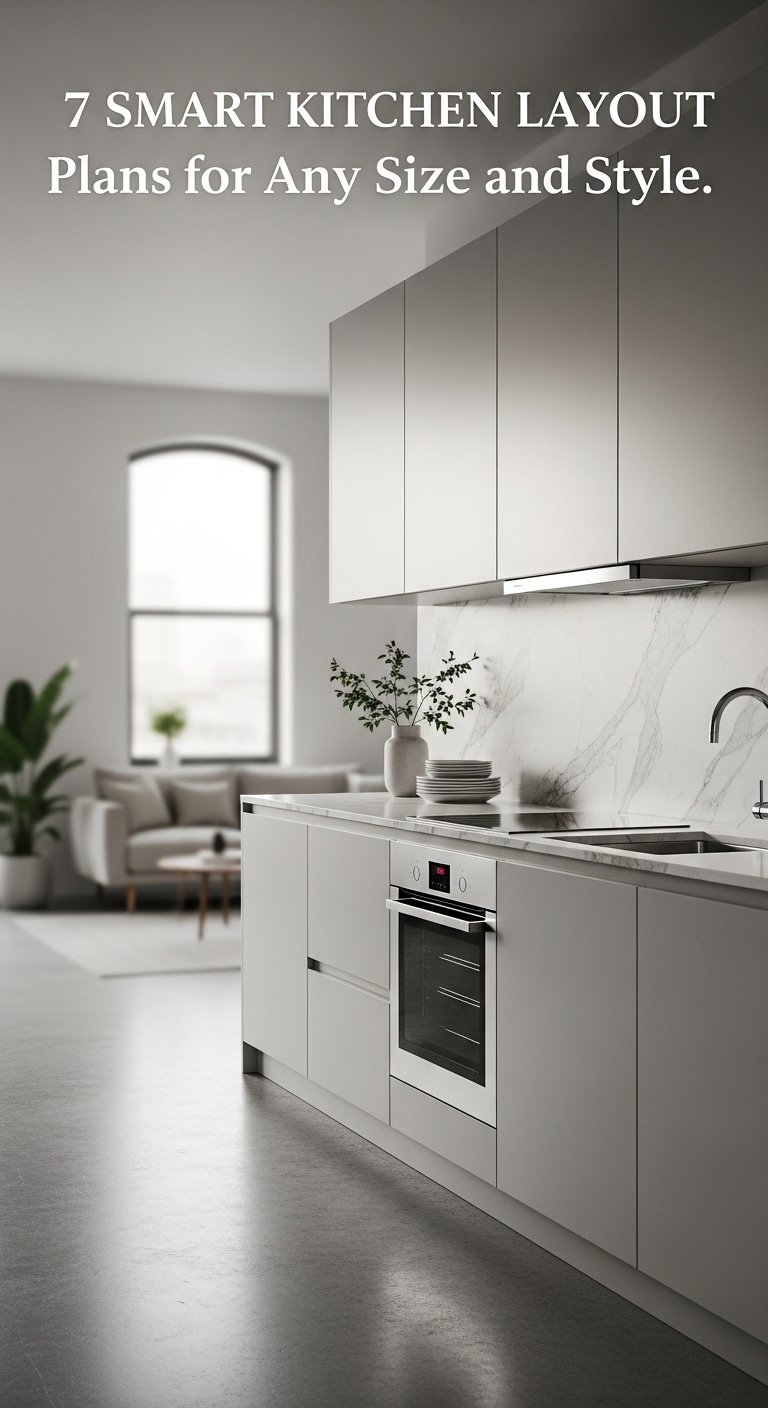
A one-wall kitchen, sometimes called a Pullman kitchen, is a layout where all cabinets, countertops, and appliances are positioned along a single wall. This design is the ultimate space-saver, perfect for long, narrow rooms or open-plan studio apartments where preserving floor space is the top priority.
Key Considerations:
- Pros: Extremely space-efficient, often the most cost-effective option for installation and materials, and it creates a wonderfully open and airy feel in small homes.
- Cons: This layout offers the least amount of counter and storage space. The workflow is linear rather than triangular, which can be less efficient for complex meal prep.
- Best For: Studio apartments, lofts, accessory dwelling units (ADUs), and secondary kitchens, such as those in a basement or guest suite.
- Dimensions: To be functional, you typically need a clear, unobstructed wall space of at least 8 feet in length.
- Pro-Tip: Maximize a one-wall kitchen by using floor-to-ceiling cabinetry to take advantage of vertical space. You can also add a rolling island or a small cart that can be moved in for extra prep space when you need it and tucked away when you don’t.
Save this minimalist layout to your ‘Small Apartment Ideas’ board!
2. The Galley Kitchen: The Efficiency Corridor
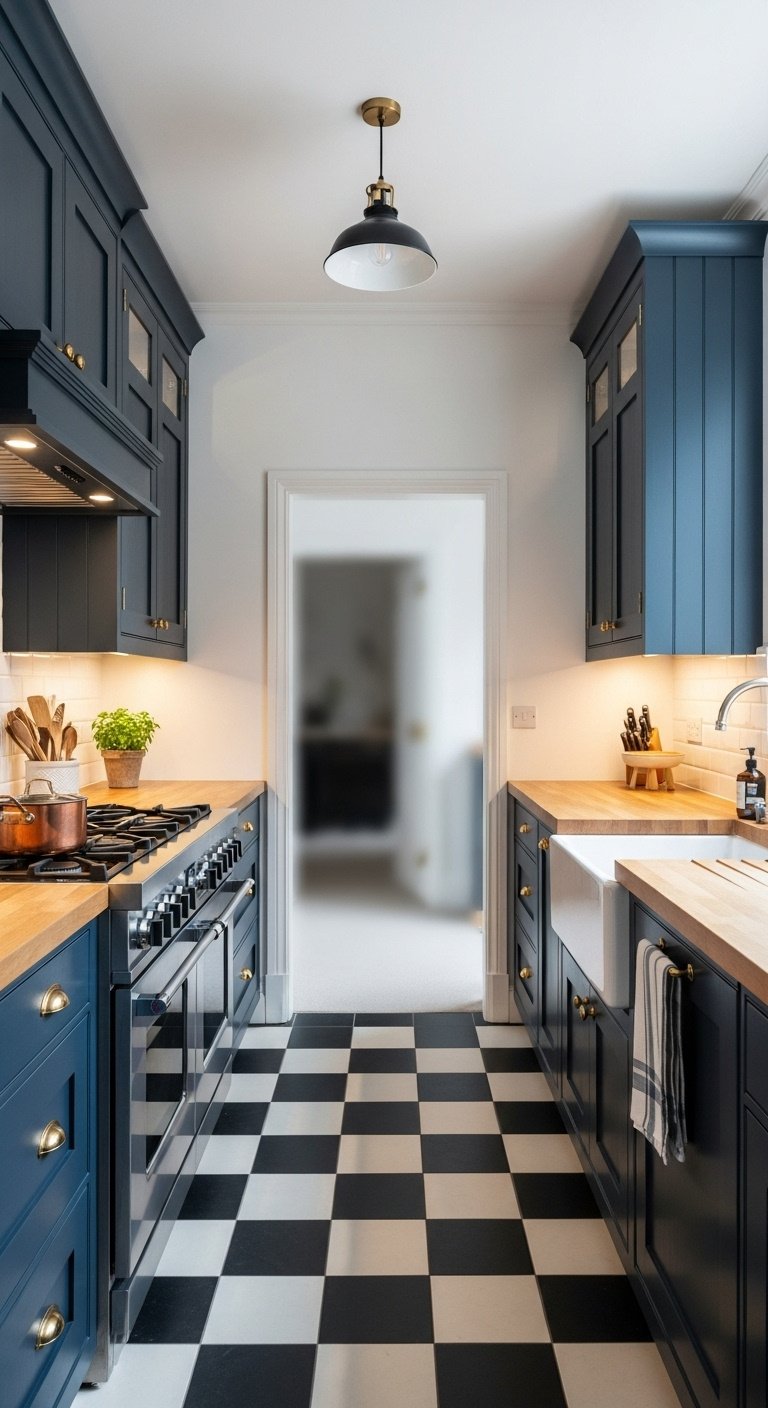
The galley kitchen, also known as a parallel kitchen, consists of two parallel walls of cabinetry and countertops with a single walkway in between. This layout is a favorite in smaller homes and apartments because it packs a tremendous amount of function into a compact footprint.
Key Considerations:
- Pros: It’s one of the most efficient layouts for a single cook, as the stove, sink, and fridge are all within a few simple pivots. It also makes great use of small, narrow spaces and eliminates wasted corner cabinets.
- Cons: The narrow corridor can feel cramped, especially with more than one person in the kitchen. There is typically no space for a dining area or seating within the kitchen itself.
- Best For: Small to medium-sized homes, condos, and apartments. It’s an ideal setup for one-cook households and for spaces that need to serve as a passageway between two other rooms.
- Dimensions: For comfortable movement and to allow appliance doors to open fully, the central walkway should be at least 3 to 4 feet wide.
- Pro-Tip: To make a galley kitchen feel wider and more open, use light-colored upper cabinets and darker base cabinets. This draws the eye upward. You can also use reflective surfaces, like a glossy backsplash or stainless steel appliances, to bounce light around and create an illusion of more space.
Pin this efficient layout for your narrow kitchen renovation!
3. The L-Shaped Kitchen: The Versatile Corner
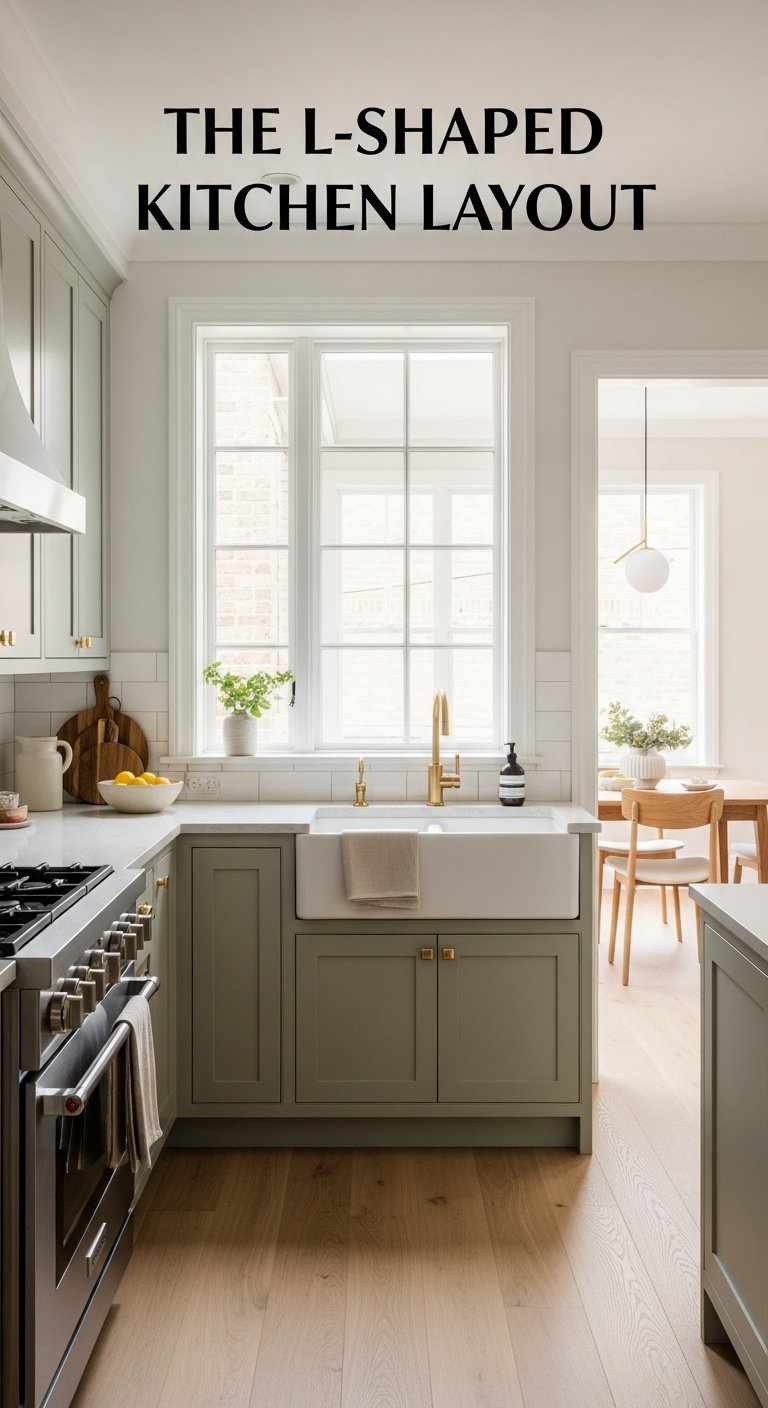
An L-shaped kitchen is one of the most popular and versatile layouts, featuring cabinetry and appliances along two adjacent, perpendicular walls. This design forms a natural and efficient work triangle and opens up the remaining space, making it perfect for integrating with a dining area or living room.
Key Considerations:
- Pros: This layout is extremely flexible and works well in small, medium, and large kitchens. It creates an excellent work triangle and keeps the cooking zone free from through-traffic. The open space is perfect for adding a kitchen island or a dining table.
- Cons: The corner cabinet can become a “dead space” if you don’t use smart storage solutions like a Lazy Susan or pull-out shelving.
- Best For: Small to medium-sized kitchens and especially for open-plan homes where you want to create a social environment that combines cooking and entertaining.
- Dimensions: For the work triangle to remain efficient, each leg of the ‘L’ should ideally be between 4 and 9 feet long.
- Lesson Learned: Many people waste the corner cabinet in an L-shaped kitchen. From personal experience, investing in a high-quality pull-out corner storage system is an absolute game-changer. It more than doubles the usable space and prevents you from having to get on your hands and knees to find a lost pot or pan.
Love this open feel? Save this L-shaped kitchen to your ‘Dream Home’ board!
4. The U-Shaped Kitchen: The Ultimate Workspace
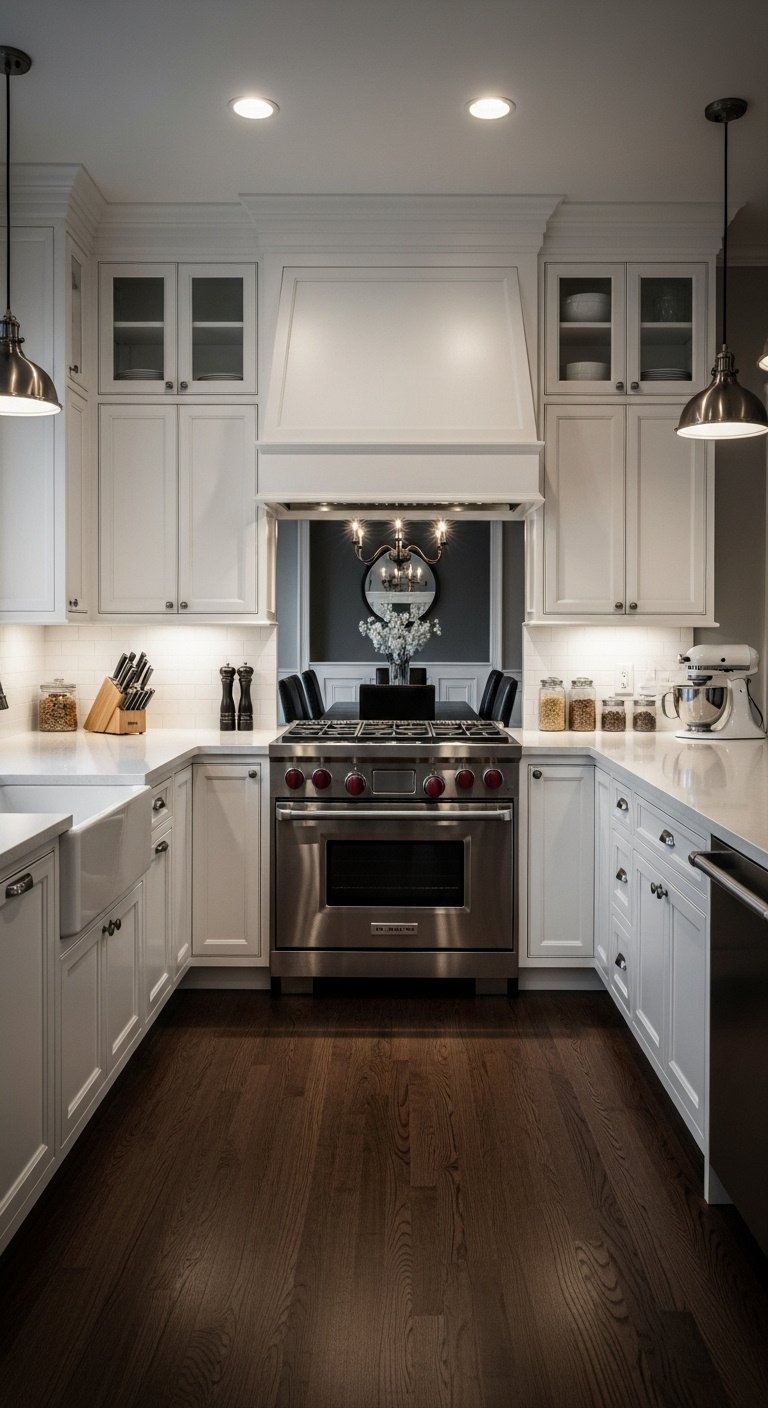
A U-shaped kitchen, also called a horseshoe kitchen, is a design that lines three walls with cabinets, countertops, and appliances. This layout is a powerhouse of storage and workspace, wrapping around the cook and keeping everything within easy reach.
Key Considerations:
- Pros: This layout offers an incredible amount of counter space and storage, making it a dream for serious home chefs. It creates a very safe and contained work triangle, free from household traffic, and can comfortably accommodate multiple cooks if the kitchen is large enough.
- Cons: In smaller spaces, a U-shape can feel enclosed and cramped. The two corners can create hard-to-access dead space if not equipped with proper storage solutions.
- Best For: Medium to large kitchens where maximizing workspace and storage is the absolute top priority.
- Dimensions: To prevent the space from feeling too tight or to accommodate a central island, the open floor space in the middle of the ‘U’ should be at least 5 to 6 feet wide.
- Pro-Tip: In a U-shaped kitchen, avoid installing upper cabinets on all three walls. This can make the space feel heavy and claustrophobic. To lighten the look and feel, consider using open shelving on one of the side walls or incorporating a window to bring in natural light.
Pin this chef’s dream kitchen for maximum counter space inspiration!
5. The G-Shaped Kitchen: The U-Shape Plus
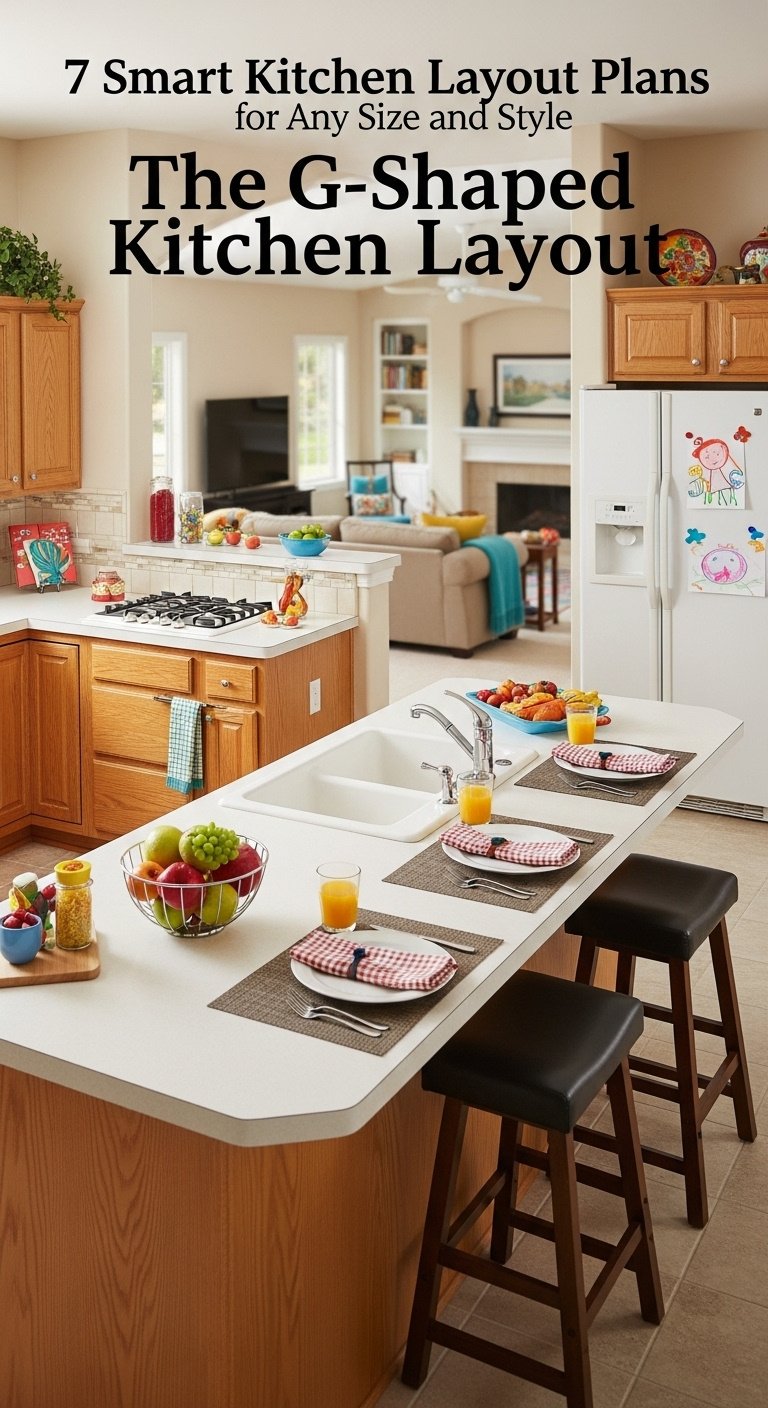
The G-shaped kitchen is essentially an enhanced U-shaped layout, with the addition of a peninsula on a fourth, partial wall. This extra arm of cabinetry and countertop provides even more surface area and often serves as a breakfast bar or serving station.
Key Considerations:
- Pros: This layout provides the absolute maximum amount of storage and counter space possible. The peninsula creates a natural, convenient spot for casual dining, homework, or socializing with the cook.
- Cons: The single entry and exit point can create bottlenecks and make the kitchen feel very enclosed. It’s crucial to plan the traffic flow carefully to avoid this.
- Best For: Large kitchens in family homes that need abundant storage and a dedicated, built-in area for casual meals or social gatherings.
- Dimensions: To avoid feeling trapped, ensure the opening to get into the main kitchen work area is at least 36-42 inches wide.
- Pro-Tip: A G-shaped layout is perfect for creating distinct “zones.” Use the peninsula as your “social zone” for family and guests, which keeps them close enough to chat but safely out of your primary cooking workflow between the stove and sink.
Need more seating? Save this peninsula idea to your ‘Family Kitchen’ board!
6. The Island Kitchen: The Social Hub
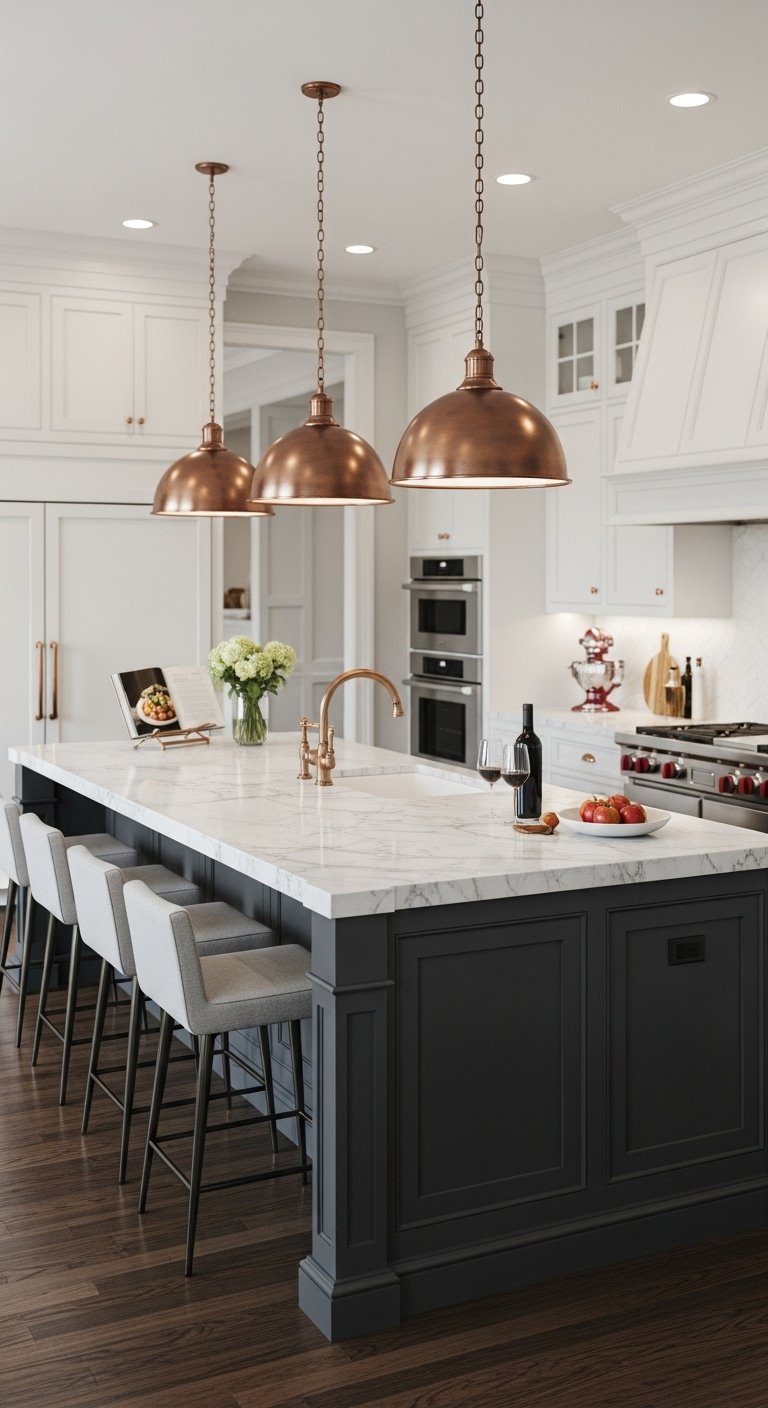
An island kitchen layout incorporates a freestanding, central counter unit into another base layout, most commonly an L-shape or One-Wall kitchen. The island can serve many purposes, from a simple prep surface to a fully equipped workstation with a sink, cooktop, and seating.
Key Considerations:
- Pros: An island adds valuable counter space, extra storage, and a prime spot for casual dining or seating. It often becomes the social hub of the home and helps to define the kitchen area within a large, open-plan space.
- Cons: Islands require a significant amount of floor space and can be expensive to install, especially if you need to run plumbing or electrical lines to it. If it’s poorly placed, it can obstruct the natural workflow.
- Best For: Medium to large kitchens, particularly in open-concept homes where the owners love to entertain and socialize while cooking.
- Dimensions: This is critical: you need at least 36-42 inches of clear walkway space around all sides of the island. Anything less will feel cramped and become a safety hazard.
- Lesson Learned: Don’t try to force an island into a kitchen that’s too small. I’ve seen it done, and a poorly placed island creates frustrating traffic jams and is more of a hindrance than a help. For smaller spaces, a peninsula or even a movable rolling cart is a much better alternative that provides extra workspace without sacrificing flow.
Pin this statement island for your ultimate entertainment kitchen goals!
7. The Peninsula Kitchen: The Attached Island
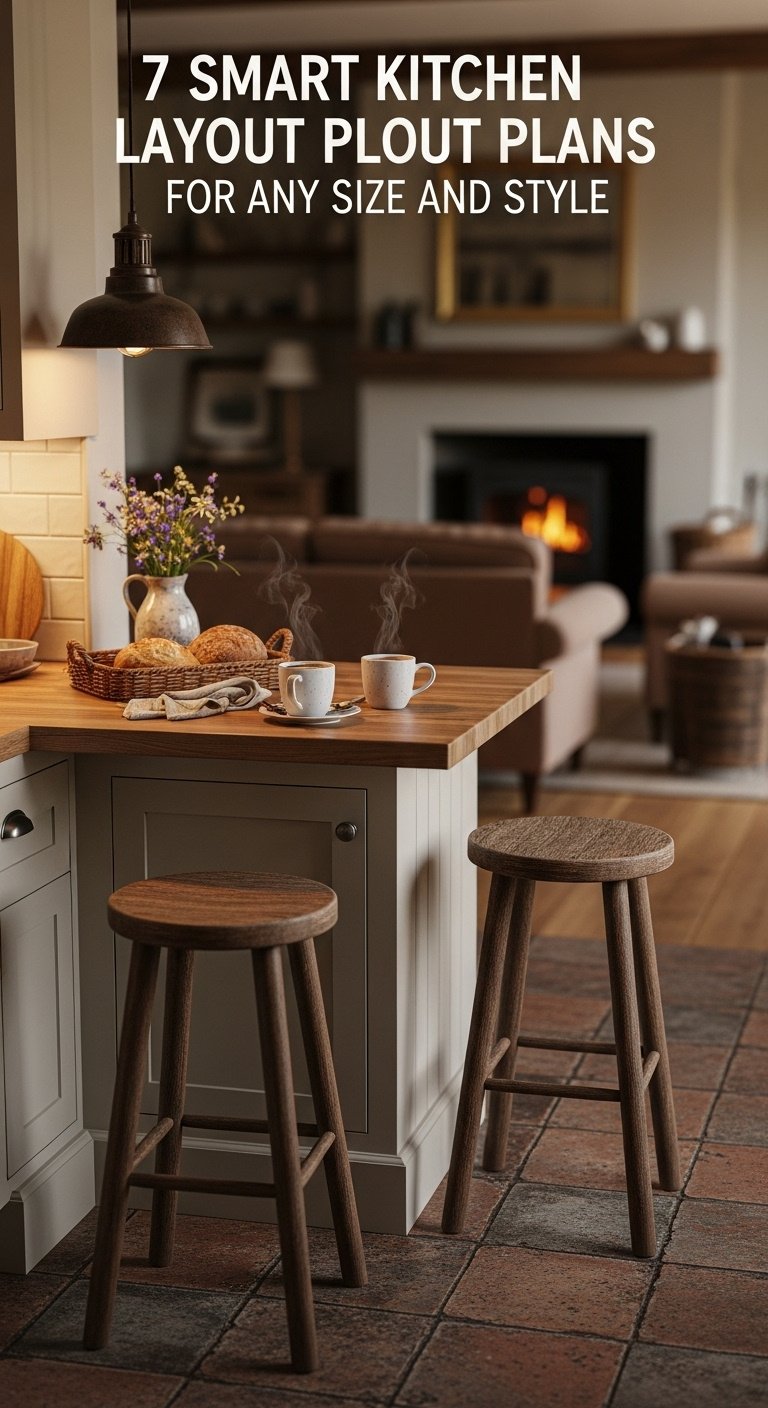
A peninsula kitchen features a connected arm of cabinetry that juts out from a wall or the end of a counter run. Think of it as an island that’s attached on one side. It offers many of the same benefits—extra counter space, storage, and seating—but in a more space-efficient design.
Key Considerations:
- Pros: It provides the open feel and casual seating of an island but requires a much smaller footprint since you only need walkway clearance on three sides. It’s excellent for dividing the kitchen from an adjacent dining or living area and helps direct traffic flow around the primary work zone.
- Cons: The fixed placement can sometimes create a bottleneck at the single entrance to the main kitchen area, similar to a G-shaped layout.
- Best For: Kitchens of any size that lack the square footage for a true, freestanding island but where the homeowners want to add seating and better define the workspace.
- Dimensions: Ensure the peninsula is long enough to be useful for seating or prep (at least 3-4 feet) but doesn’t extend so far that it blocks major traffic paths in the adjoining room.
- Pro-Tip: A peninsula is a fantastic and cost-effective way to convert a simple L-shaped kitchen into a more functional U-shape. It adds valuable seating and storage without the major expense or structural changes of moving walls.
Save this smart peninsula idea for defining your open-plan space!
Key Takeaways: Your Quick Guide to Kitchen Layout Plans
Feeling clearer? Here’s a quick-glance summary to help you remember the core strengths of each kitchen layout plan.
- One-Wall: Best for tight spaces; linear, open, and budget-friendly.
- Galley: Best for narrow rooms; highly efficient corridor for one cook.
- L-Shaped: The most versatile; great for open-plan living and a natural workflow.
- U-Shaped: The “chef’s kitchen”; offers maximum counter and storage space.
- G-Shaped/Peninsula: Adds seating and defines space without needing a full island.
- Island: The social hub; requires a large room and is perfect for entertaining.
- The Golden Rule: Always prioritize the “work triangle” (stove, sink, fridge) and ensure you have adequate clearance (at least 36-42 inches) for walkways and appliance doors.
People Also Ask About Kitchen Layout Plans
What is the best layout for my kitchen?
The best layout depends on your kitchen’s size, shape, and how you use it. For small or narrow kitchens, a Galley or One-Wall layout is most efficient. L-Shaped kitchens are incredibly versatile for most spaces and work well with open-plan homes. If you have a large room and need maximum storage and counter space, a U-Shaped or Island layout is ideal.
How do I decide where to put things in my kitchen?
Use the “work zone” concept by grouping items based on their task. Place pots, pans, and cooking utensils near the stove. Put dishes, glasses, and silverware near the dishwasher for easy unloading. Locate food storage containers, plastic wrap, and foils near the refrigerator for storing leftovers. This strategy keeps everything you need for a specific task within arm’s reach.
Is there a free app to design a kitchen?
Yes, there are several excellent free online tools available. Many big-box home improvement stores like IKEA, Lowe’s, and Home Depot offer free 3D kitchen planner software on their websites. These powerful tools allow you to input your room’s dimensions, drag and drop cabinets and appliances, and visualize your chosen layout in both 2D and 3D.
What is the “work triangle” rule in a kitchen?
The work triangle is a core design principle connecting the three main work areas: the sink, the stove, and the refrigerator. To ensure an efficient kitchen, each leg of the triangle should measure between 4 and 9 feet. The total distance of all three legs combined should ideally be no more than 26 feet to avoid taking too many steps while cooking.
Final Thoughts
Choosing a kitchen layout is the most important decision you’ll make in your kitchen renovation. It sets the foundation for how your space will look, feel, and function for years to come. Remember that the perfect kitchen layout is always a balance between these proven design principles and your own personal needs.
Use these seven layouts as your blueprint, not as a strict set of rules. Think about how you cook, how your family gathers, and what your biggest frustrations are with your current kitchen. The right plan will solve those problems and create a space that brings you joy every single day.
Which kitchen layout are you dreaming of for your home? Let me know in the comments below
